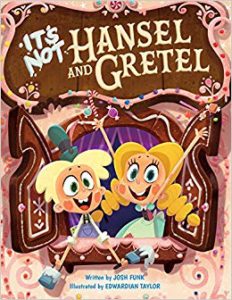 It’s Not Hansel and Gretel (It’s Not a Fairy Tale)
It’s Not Hansel and Gretel (It’s Not a Fairy Tale)
Author: Josh Funk
Illustrator: Edwardian Taylor
Two Lions
1 March 2019
40 pages
This month’s PB review is by Ryan G. Van Cleave (#1 fairy tale fan at Only Picture Books) and Ringling College of Art and Design Illustration Professor (and OPB mega-fan) David C. Gardner.
–Ryan’s Review of the Writing–
It’s Not Hansel and Gretel is the newest Josh Funk book, and if you’ve read any of his picture books before (such as Lady Pancake & Sir French Toast, How to Code a Sandcastle, and Lost the Library: A Story of Patience & Fortitude), you know to expect:
- an unexpected take on subject matter
- a kid-friendly sense of whimsy
- witty wordplay
It’s official–It’s Not Hansel and Gretel delivers on all counts.
There’s a narrator here trying their best to keep this story under control, but the rapscallion duo of Hansel and Gretel keep yanking this fairy tale in different directions. The art clues us in when this happens by using speech bubbles that work against the words the narrator uses, which are in cast in a fancy, Old Timey font that seems straight out of the days of illuminated manuscripts written by monks beneath candlelight.
To offer just one example of how these kids push the story off the rails, the poor narrator tells the reader how the pair “left a trail of bread crumbs leading back home” to which the kids respond with:
Gretel: What type of person SAVES bread crumbs?
Hansel: It’s a time of great famine. If there are bread crumbs left, we eat them!
Gretel: Now I’m hungry! Why’d you have to bring up bread crumbs?
Things get worse from there for the narrator who wants to stick with the traditional story, with my favorite moment being when Gretel asks, “Why isn’t it ever Gretel and Hansel?” She even points out that alphabetically speaking, G comes before H, and while a giggling kid reader likely doesn’t stop to think about the problem of legacy thinking–doing something because it’s always been done that way, or perhaps subconsciously privileging males more than females–those topics are there for adults who want to dive into that end of the pool.
One clear instance of Funk’s wordplay happens when the witch begins to cast a spell, intoning “Double, double toil and trouble.” And Gretel says, “I can’t hear you over that noisy oven. Did you say TOILET trouble?”
That’s a burst-out-loud kid pleasing moment, to be sure. It’s entirely possible a member of the OPB staff had chocolate milk come out of their nose thanks to laughter here, as well.
I’m also quite taken with how the kids are practical and have a positivity about them that helps save the day. Those are two good lessons beyond the legacy thinking idea and issues of gender and power that are lightly touched upon during the course of this story.
The ending, too, is full of cameos from other fairy tale friends, and it’s a surprising yet satisfying conclusion to this irreverent take on an old, old tale. Highly recommended. For those who get a real kick out of this kind of fun, check out the first book in Funk’s It’s Not a Fairy Tale series–It’s Not Jack and the Beanstalk.
4.75 out of 5 pencils
– David’s Review of the Illustrations–
In the 1800s, children’s books were meant for moral education. But in the last century, some argued that it was enough to aim to entertain a child.
There’s no deep message in It’s Not Hansel and Gretel, but it’s a heap of entertaining fun.
Flipping through the illustrations by Edwardian Taylor is like watching a cartoon on TV, one of those vintage Fractured Fairytales, or Powerpuff Girls. This no accident; Taylor also designs for animation. I’ll confess, I’m not a big fan of the trend of children’s books mimicking slick Cartoon Network shows, but Taylor knows his stuff, and he takes full advantage of the picture book form, packing each spread with funny visual asides for kids (and adults). Look closely and you’ll discover treats on every page: Thumbelina in a corner chatting with a bird twice her size, the Seven Dwarves marching to work in the forest background, cute recurring elves in just about every spread. The clever, ebullient pictures establish from the start that we are in a world populated by fairy tale characters (a device that pays off wittily in the end–but I won’t give anything away.…)
Another note on the visuals: The great art direction makes it a breeze to tell who is talking on each page; every voice has its own font, a trick Walt Kelly pioneered in his classic comic strip Pogo.
Taylor’s character designs are fluid and manic in a way that perfectly fits the story’s tone, and his color palette is fabulous, too–muted greens and browns in the opening pages make way for the explosion of candy colors when the kids discover the gingerbread house. Close-ups pull us into the center of the action, sometimes making an image hard to read at first glance. But in a picture book, where the child has plenty of time to peruse a picture, that’s not a problem. Add the bright, but controlled, colors–as sweet as the witch’s house–and you’ve got a book that’s an immersive experience, a cool hybrid of children’s book and animated cartoon, a perfect confection for our time.
5 out of 5 crayons
 David C. Gardner is an award-winning illustrator and visual development artist. A former artist for Walt Disney Animation Studios, he has illustrated numerous picture books, including his latest from Sleeping Bear Press, Write On, Irving Berlin! by Leslie Kimmelman (which appeared on OPB not so long ago). It tells the true story of little Izzy Baline, who immigrated to New York City in 1893 and grew up to become Irving Berlin, one of the most well-known composers of popular music in America. David teaches illustration at Ringling College of Art and Design.
David C. Gardner is an award-winning illustrator and visual development artist. A former artist for Walt Disney Animation Studios, he has illustrated numerous picture books, including his latest from Sleeping Bear Press, Write On, Irving Berlin! by Leslie Kimmelman (which appeared on OPB not so long ago). It tells the true story of little Izzy Baline, who immigrated to New York City in 1893 and grew up to become Irving Berlin, one of the most well-known composers of popular music in America. David teaches illustration at Ringling College of Art and Design.
